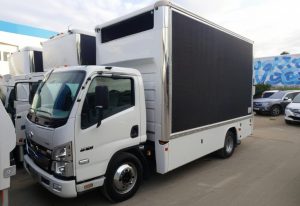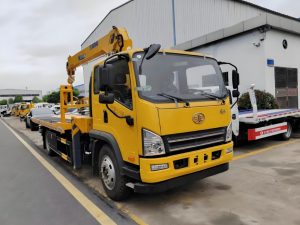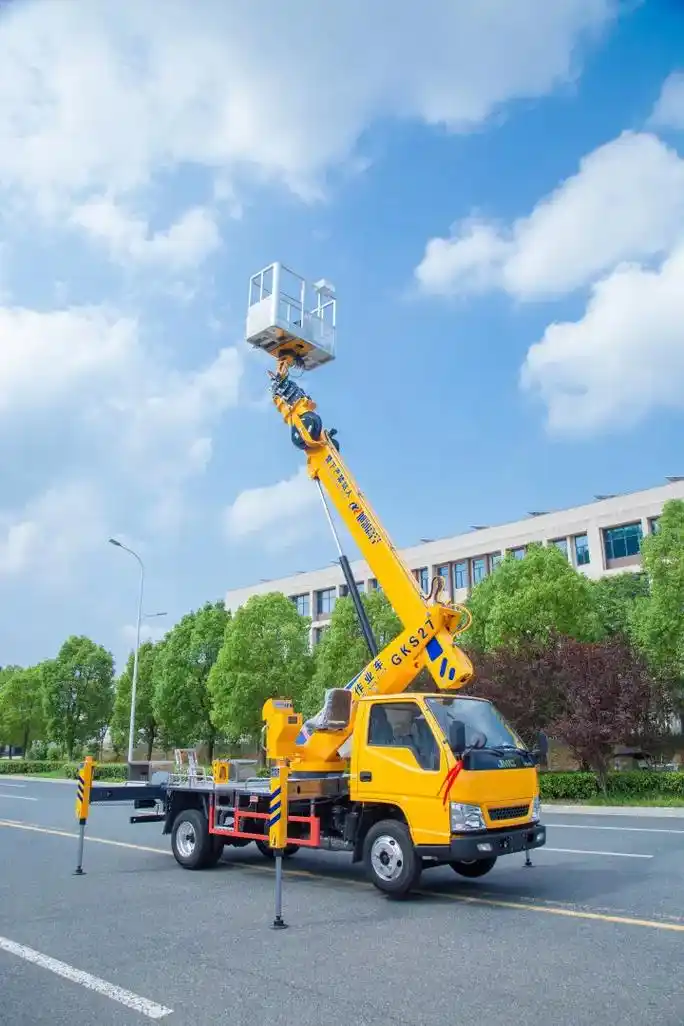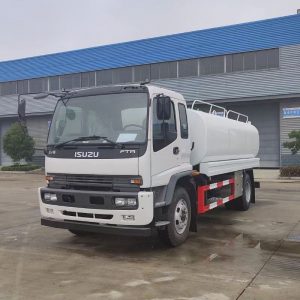
Introduction
When you think of construction sites, oil rigs, or utility maintenance, one common piece of equipment often comes to mind: the truck mounted crane. These versatile machines are crucial in various industries, providing the muscle needed to lift, move, and position heavy loads with precision and efficiency. But what makes these cranes so essential? How have they evolved over the years? Let’s delve deeper into the world of truck mounted cranes and uncover their significance.
History of Truck Mounted Cranes
The journey of truck mounted cranes is a fascinating one, tracing back to the early days of industrialization. The initial models were rudimentary, designed primarily for basic lifting tasks. These early cranes lacked the sophistication and versatility we see today, but they laid the groundwork for future innovations.
Early Development
The first truck mounted cranes were essentially modified trucks with simple lifting mechanisms. These early models were manually operated, requiring significant physical effort from operators. They were primarily used in construction and mining, where there was a dire need to lift heavy materials.
Evolution Over the Years
As industries grew and technology advanced, so did the design and functionality of truck mounted cranes. The introduction of hydraulic systems in the mid-20th century revolutionized these machines, allowing for more powerful and precise movements. Over the years, advancements in materials science, control systems, and safety features have transformed truck mounted cranes into the sophisticated equipment we see today.
Types of Truck Mounted Cranes
Understanding the different types of truck mounted cranes can help you choose the right one for your needs. Each type has its unique features and is suited for specific applications.
Telescopic Cranes
These cranes feature a boom with several tubes fitted one inside the other. A hydraulic system extends or retracts the tubes, allowing the boom to adjust its length. Telescopic cranes are known for their reach and are commonly used in applications where high lifting heights are required.
Knuckle Boom Cranes
Also known as articulating cranes, knuckle boom cranes have a jointed boom that can fold back like a finger. This flexibility makes them ideal for tasks requiring precise movements in tight spaces. They are often used in utility work, where maneuverability is crucial.
Stiff Boom Cranes
Stiff boom cranes, or straight boom cranes, have a fixed boom that doesn’t articulate but can extend or retract telescopically. They are often used for straightforward lifting tasks and are known for their stability and lifting capacity.
Components of Truck Mounted Cranes
A truck mounted crane is more than just a boom on a truck; it’s a complex machine with multiple components working in harmony. Understanding these components can help you appreciate the engineering marvel that these machines are.
Boom
The boom is the primary lifting structure. Its length and strength determine the crane’s reach and load capacity. Different types of booms are used depending on the specific requirements of the job.
Hydraulic System
The hydraulic system powers the movement of the boom and other components. It’s the lifeblood of the crane, converting hydraulic energy into mechanical work. Modern hydraulic systems are highly efficient and allow for precise control over the crane’s movements.
Outriggers
Outriggers are extendable supports that stabilize the crane during operations, ensuring it doesn’t tip over. They are crucial for maintaining balance, especially when lifting heavy loads or working on uneven terrain.
Control System
Modern cranes come equipped with advanced control systems that allow operators to maneuver the boom with precision and safety. These systems often include features like remote control operation, load monitoring, and automatic safety checks.
Advantages of Using Truck Mounted Cranes
Why are truck mounted cranes so popular? Let’s break down their benefits and understand why they are indispensable in various industries.
Mobility and Flexibility
One of the biggest advantages is their mobility. Unlike stationary cranes, truck mounted cranes can be driven to different job sites, offering unparalleled flexibility. This mobility reduces downtime and increases efficiency, as the crane can quickly move from one task to another.
Cost-Effectiveness
They eliminate the need for multiple machines by combining transportation and lifting capabilities into one unit, reducing overall costs. This cost-effectiveness makes them an attractive option for many businesses, especially those operating on tight budgets.
Versatility
From construction sites to oil rigs, these cranes are versatile enough to handle a wide range of tasks across various industries. Their ability to adapt to different environments and applications makes them a valuable asset in any industrial operation.
Applications in Different Industries
Truck mounted cranes are indispensable in many sectors. Their versatility and efficiency make them suitable for a wide range of applications.
Construction
In construction, they are used for lifting heavy materials like steel beams, concrete slabs, and construction equipment. Their ability to quickly move around the site and reach high places makes them invaluable in building projects.
Oil and Gas
They play a crucial role in oil and gas operations, from transporting drilling equipment to assembling rigs. The harsh conditions of oil fields require robust and reliable equipment, making truck mounted cranes an ideal choice.
Utilities and Maintenance
Utility companies use them for tasks like setting poles, repairing power lines, and maintaining infrastructure. Their flexibility and maneuverability allow them to access hard-to-reach areas, making maintenance work more efficient.
Transportation and Logistics
In logistics, they help load and unload heavy cargo, making supply chain operations more efficient. Their ability to handle large and bulky items streamlines the loading process, reducing delays and increasing productivity.
Safety Measures and Regulations
Operating a truck mounted crane isn’t just about skill; it’s also about safety. Adhering to safety measures and regulations is crucial to prevent accidents and ensure smooth operations.
Operator Training and Certification
Operators must undergo rigorous training and obtain certification to ensure they can handle the equipment safely. Proper training covers not only operating techniques but also safety protocols and emergency procedures.
Regular Maintenance and Inspections
Regular maintenance is crucial for keeping the crane in optimal condition and preventing accidents. Scheduled inspections help identify potential issues before they become serious problems, ensuring the crane operates safely and efficiently.
Safety Gear and Protocols
Operators should always wear appropriate safety gear and follow established protocols to minimize risks. This includes wearing helmets, gloves, safety vests, and adhering to guidelines for safe operation.

How to Choose the Right Truck Mounted Crane
Selecting the right truck mounted crane for your needs involves careful consideration of various factors. Making the right choice can significantly impact the efficiency and safety of your operations.
Assessing Project Requirements
Start by evaluating the specific needs of your project. What kind of loads will you be lifting? How far do you need to reach? Consider the nature of the tasks you’ll be performing and the environment in which the crane will operate. For instance, a construction site with limited space might benefit from a knuckle boom crane, while a project requiring high lifting might need a telescopic crane.
Considering Load Capacity
Make sure the crane you choose can handle the maximum load you expect to lift. Overloading a crane can lead to dangerous situations, so it’s crucial to select a model with an appropriate load capacity. Consult with manufacturers and review technical specifications to ensure you make an informed decision.
Evaluating Mobility Needs
Consider how often you’ll need to move the crane between job sites. A more mobile crane may be worth the investment if you frequently change locations. Mobility not only saves time but also reduces the logistical complexities associated with transporting heavy equipment.
Maintenance Tips for Longevity
Proper maintenance can extend the life of your truck mounted crane and ensure it operates safely and efficiently. Here are some essential maintenance tips:
Regular Inspections
Conduct regular inspections to identify any wear and tear early on. Look for signs of damage or malfunction in critical components like the boom, hydraulic system, and outriggers. Regular inspections help prevent unexpected breakdowns and costly repairs.
Proper Lubrication
Keep all moving parts well-lubricated to ensure smooth operation. Lubrication reduces friction and wear, prolonging the life of components. Follow the manufacturer’s recommendations for lubrication intervals and types of lubricants to use.
Timely Repairs and Replacements
Don’t delay necessary repairs or replacements; addressing issues promptly can prevent more serious problems down the line. Regularly replace worn-out parts and fix minor issues before they escalate into major failures. A proactive approach to maintenance can save time, money, and enhance safety.
Technological Innovations
Technology is continually improving truck mounted cranes, making them more efficient, safer, and easier to operate. Here are some of the latest technological innovations in this field:
Advanced Control Systems
Modern cranes come with sophisticated control systems that enhance precision and safety. These systems often include features like remote control operation, load monitoring, and automatic safety checks. Advanced control systems allow operators to perform complex tasks with ease and accuracy.
Integration with IoT
Internet of Things (IoT) technology allows for real-time monitoring of crane performance, helping operators make informed decisions. IoT sensors can track parameters like load weight, boom angle, hydraulic pressure, and more. This data can be used to optimize operations, predict maintenance needs, and improve overall efficiency.
Use of AI and Machine Learning
Artificial Intelligence (AI) and Machine Learning are being integrated to predict maintenance needs and optimize operations. AI algorithms can analyze data from IoT sensors to identify patterns and anomalies, enabling predictive maintenance. Machine Learning models can also assist in optimizing lifting strategies and improving safety protocols.
Environmental Impact and Sustainability
Sustainability is becoming increasingly important in all industries, including those that use truck mounted cranes. Manufacturers are focusing on reducing the environmental impact of their machines through various initiatives:
Fuel Efficiency
Newer models are designed to be more fuel-efficient, reducing their environmental footprint. Improved engine designs, hybrid powertrains, and energy-efficient hydraulic systems contribute to lower fuel consumption. Fuel-efficient cranes not only save money but also reduce greenhouse gas emissions.
Emission Controls
Stringent emission controls help minimize air pollution caused by these machines. Modern cranes are equipped with advanced exhaust treatment systems that reduce harmful emissions like nitrogen oxides (NOx) and particulate matter (PM). Compliance with emission standards ensures that cranes operate in an environmentally responsible manner.
Recycling and Disposal
Responsible recycling and disposal practices ensure that old or broken parts don’t end up harming the environment. Manufacturers are increasingly adopting circular economy principles, designing cranes with recyclable materials and promoting end-of-life recycling programs. Proper disposal of hydraulic fluids, batteries, and other hazardous materials is also essential for environmental protection.
Case Studies and Success Stories
Real-world examples can provide valuable insights into the effectiveness of truck mounted cranes. Let’s explore some notable projects and testimonials from industry experts:
Notable Projects Using Truck Mounted Cranes
Highlighting successful projects can demonstrate the versatility and efficiency of these machines. For example, truck mounted cranes played a crucial role in constructing iconic structures like skyscrapers, bridges, and stadiums. Their ability to handle heavy loads and reach great heights made them indispensable in these projects.
In another instance, a major oil company used truck mounted cranes to assemble offshore drilling rigs. The cranes’ mobility allowed them to be transported to remote locations, where they efficiently lifted heavy equipment onto platforms. This streamlined the assembly process and reduced project timelines.
Testimonials from Industry Experts
Hearing from experts who use these cranes daily can offer practical perspectives on their benefits and challenges. An experienced crane operator might share how advanced control systems have improved precision and safety in lifting operations. A project manager could discuss how the mobility of truck mounted cranes has enhanced logistics and reduced costs on construction sites.
Industry experts often highlight the importance of proper training, maintenance, and adherence to safety protocols. Their insights can help others make informed decisions when choosing and operating truck mounted cranes.
Common Challenges and Solutions
Even with all their advantages, truck mounted cranes come with their own set of challenges. Understanding these challenges and implementing effective solutions is crucial for successful operations:
Overcoming Terrain Obstacles
Rough or uneven terrain can be a challenge, but using outriggers effectively can provide stability. Operators should assess the ground conditions before setting up the crane and extend outriggers fully to ensure balance. In extreme cases, additional support structures or ground mats may be needed to stabilize the crane.
Managing Heavy Loads Safely
Proper load management techniques are essential for preventing accidents during lifting operations. Operators should adhere to load charts provided by manufacturers and avoid exceeding the crane’s rated capacity. Using proper rigging techniques, such as balancing loads and securing them with appropriate slings, is crucial for safe lifting.
Dealing with Weather Conditions
Weather conditions like high winds or rain can affect crane operations. Always check weather forecasts before starting work. High winds can destabilize a crane, so it’s important to follow guidelines for safe wind speeds during lifting operations. Rain can reduce visibility and create slippery surfaces, so operators should exercise caution and take necessary precautions.
Future Trends in Truck Mounted Cranes
The future of truck mounted cranes is bright, with several exciting trends on the horizon. As technology continues to advance, these machines are expected to become even more efficient, safer, and environmentally friendly. Let’s explore some of the key trends shaping the future of truck mounted cranes:
Increased Automation
Automation is set to revolutionize the way truck mounted cranes are operated. With advancements in robotics and control systems, cranes will become increasingly autonomous, reducing the need for manual intervention. Automated cranes can perform repetitive tasks with high precision, improving productivity and safety.
Enhanced Safety Features
Safety is always a top priority in crane operations, and future models will come equipped with even more advanced safety features. These may include enhanced load monitoring systems, collision avoidance technology, and real-time data analytics to predict and prevent potential hazards. Enhanced safety features will help minimize accidents and protect both operators and surrounding personnel.
Sustainable Practices
As industries worldwide shift towards sustainability, truck mounted cranes will also adopt more eco-friendly practices. This includes the use of renewable energy sources, such as electric or hybrid powertrains, to reduce carbon emissions. Manufacturers will continue to develop cranes with lower environmental impact, focusing on energy efficiency and recyclable materials.
Integration with Augmented Reality (AR)
Augmented Reality (AR) technology has the potential to transform crane operations by providing operators with real-time visual information. AR headsets can overlay digital information onto the operator’s field of view, such as load weights, boom angles, and safe lifting zones. This technology enhances situational awareness and allows for more precise control of the crane.
Remote Monitoring and Control
Remote monitoring and control capabilities will become more prevalent in future truck mounted cranes. Operators can control cranes from a distance using advanced remote-control systems, reducing the need for physical presence on-site. Remote monitoring allows for real-time diagnostics and troubleshooting, improving overall efficiency and reducing downtime.
Predictive Maintenance
Predictive maintenance uses data analytics and machine learning to predict when a crane will require maintenance or repairs. By analyzing historical data and real-time sensor information, predictive maintenance systems can identify patterns and anomalies that indicate potential issues. This proactive approach helps prevent unexpected breakdowns and extends the lifespan of the crane.
Conclusion
Truck mounted cranes are indispensable tools that have evolved significantly over the years. With their versatility, mobility, and cost-effectiveness, they play a vital role in various industries, from construction to oil and gas to utilities and logistics. As technology advances, we can look forward to even more innovative features that will make these machines safer, more efficient, and environmentally friendly.
In summary, we’ve explored the history, types, components, advantages, applications, safety measures, selection criteria, maintenance tips, technological innovations, environmental impact considerations, case studies, common challenges, and future trends related to truck mounted cranes. These machines are not only engineering marvels but also essential assets that drive productivity and efficiency across multiple sectors.
The future of truck mounted cranes is promising, with increased automation, enhanced safety features, sustainable practices, AR integration, remote monitoring and control, and predictive maintenance leading the way. As industries continue to evolve, truck mounted cranes will remain at the forefront of innovation, adapting to new challenges and opportunities.
Whether you’re involved in construction, oil and gas, utilities, or logistics, understanding the capabilities and advancements of truck mounted cranes can help you make informed decisions and maximize the benefits these machines offer. Embracing new technologies and adhering to best practices will ensure that truck mounted cranes continue to be reliable workhorses that contribute to the success of your projects.
In conclusion, truck mounted cranes are more than just lifting machines; they are integral components of modern industrial operations. Their ability to adapt to various environments and tasks makes them invaluable assets that drive progress and efficiency. As we look to the future, we can expect even greater innovations that will further enhance their performance and sustainability.







